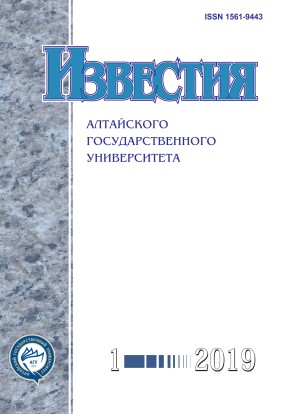Multi-Frequency Eddy Current Testing of Copper Based Magnetic Alloys Using the Principal Component Analysis
Downloads
Metrics
References
Егоров А.В., Поляков В.В., Иваков С.В. Измерительно-вычислительный комплекс для определения удельной электропроводности и магнитной проницаемости методом вихревых токов // Ползуновский вестник. 2010. № 2.
Поляков В.В., Егоров А.В. Магнитные и электрические характеристики пористых ферромагнетиков // Доклады Академии наук. 1995. Т. 344, № 4.
Lulu Tian, Yuhua Cheng, Chun Yin, Xuegang Huang, 1 Bo Zhang, and Libing Ba. Data-Driven Method for the Measurement of Thickness/Depth Using Pulsed Eddy Current // Sensors and Materials. 2017. Vol. 29, No9.
Yang H.C., Tai C.C. Pulsed eddy-current measurement of a conducting coating on a magnetic metal plate // Measurement Science and Technology. 2002. Vol. 13.
Mercier D, Lesage J, Decoopman X, Chicot D. Eddy currents and hardness testing for evaluation of steel decarburizing // NDT E Int. 2006. №39.
Song Z, Yamada T, Shitara H, Takemura Y. Detection of Damage and Crack in Railhead by Using Eddy Current Testing // J. Electromagn. Anal. Appl. 2011. №3.
Zenglu Song, Tsutomu Yamada, Hideki Shitara, Yasushi Takemura. Detection of Damage and Crack in Railhead by Using Eddy Current Testing // Journal of Electromagnetic Analysis and Applications. 2011. № 3.
Sasi B., Rao B.PC., Jayakumar T., and Raj Baldev. Development of Eddy Current Test Procedure for Nondestructive Detection of Fatigue Cracks and Corrosion in Rivets of Air-intake Structures // Defence Science Journal, 2009. Vol. 59, No2.
Lingqi Li, Tsukada K., Hanasaki K., Zheng Liu. Fusion of multi-frequency eddy current signals-by using wavelet analysis method // Proceedings of the Fifth International Conference on Information Fusion. 2002. Vol. 1.
Egorov A.V., Polyakov V.V., Salita D.S., Kolubaev E.A., Psakhe S.G., Chernyavsky A.G., Vorobei I.V. Inspection of aluminum alloys by a multi-frequency eddy current method // Defence Technology. 2015. Т. 11, № 2.
Pedersen LB, K.-A. M, Zhengsheng Y. Eddy Current Testing of Thin Layers Using Co-planar Coils // Nondestruct. Eval. 2000. Vol. 12.
Esbensen K/H, Geladi P. Principal Component Analysis: Concept, Geometrical Interpretation, Mathematical Background, Algorithms, History, Practice. In: Brown E-CSD, Tauler R, and Beata Walczak, editors. Compr. Chemom. Oxford, 2009.
Comon P. Independent component analysis, A new concept? // Signal Processing. 1994. Vol. 36.
Wold S, Sjostrom M, Eriksson L. PLS-regression: a basic tool of chemometrics // Chemom. Intell. Lab. Vol. 2001.
Егоров А.В., Поляков В.В. Вихретоковый контроль металлических материалов с помощью проекционных методов многомерного анализа данных // Дефектоскопия. 2018. №5.
Izvestiya of Altai State University is a golden publisher, as we allow self-archiving, but most importantly we are fully transparent about your rights.
Authors may present and discuss their findings ahead of publication: at biological or scientific conferences, on preprint servers, in public databases, and in blogs, wikis, tweets, and other informal communication channels.
Izvestiya of Altai State University allows authors to deposit manuscripts (currently under review or those for intended submission to Izvestiya of Altai State University) in non-commercial, pre-print servers such as ArXiv.
Authors who publish with this journal agree to the following terms:
- Authors retain copyright and grant the journal right of first publication with the work simultaneously licensed under a Creative Commons Attribution License (CC BY 4.0) that allows others to share the work with an acknowledgement of the work's authorship and initial publication in this journal.
- Authors are able to enter into separate, additional contractual arrangements for the non-exclusive distribution of the journal's published version of the work (e.g., post it to an institutional repository or publish it in a book), with an acknowledgement of its initial publication in this journal.
- Authors are permitted and encouraged to post their work online (e.g., in institutional repositories or on their website) prior to and during the submission process, as it can lead to productive exchanges, as well as earlier and greater citation of published work (See The Effect of Open Access).








